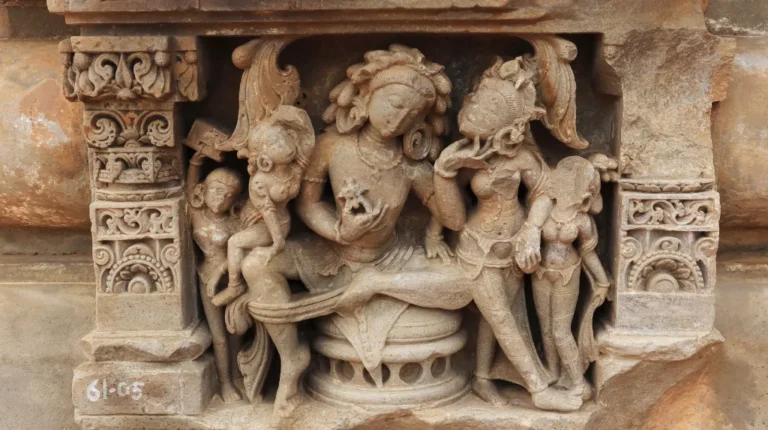Stepwells are unique and ancient water storage structures built over the centuries in different regions of India. These spectacular wells were designed with a series of steps leading to the water. One such stunning example is Chand Baori.
Chand Baori is the most impressive and largest stepwell in India, and probably one of the largest in the world. This magnificent structure is located in the small village of Abhaneri in Rajasthan, which is why it is also known as Abhaneri Stepwell. This historical architectural marvel showcases the brilliance of ancient Indian engineering and architecture. With its intricately carved walls, grand symmetrical staircases, and stunning reflections in the water, Chand Baori is truly a sight to behold.
History of Chand Baori
In the 9th century, King Chanda of the Nikumbh Dynasty constructed Chand Baori. He dedicated the well to Hashat Mata, the goddess of joy. The well was designed to serve as a water source for the local community. Stepwells were an important aspect of Indian architecture during that era. These wells were essential for collecting and storing rainwater during the monsoon season, and the water could then be used for drinking, irrigation, and other daily needs throughout the year.
Some parts of the stepwell date back to the 8th century, and it was later expanded by the Chauhan rulers who added an upper palace building. This building can be seen through tabular arches and further enhances the site’s beauty and magnificence.
Chand Baori Architecture


Chand Baori is an outstanding example of ancient Indian engineering and architecture. The well has a unique design that has 13 levels, consisting of 3,500 perfectly symmetrical steps. The depth of the well is about 30 meters. It is surrounded by a multi-storied pavilion with beautifully carved pillars and sculptures. The walls of the well are intricately carved with elaborate patterns and motifs, making it a stunning sight to see.
What makes Chand Baori even more fascinating is how it’s built to make the most out of light and shadow effects. The stepwell is designed to create an optical illusion where the steps and the water at the bottom of the well appear to be closer than they actually are. When you see the stepwell’s intricate carvings, along with the clever use of light and shadow, it creates an amazing sight that takes your breath away.
The architecture of Chand Baori is not only impressive but also functional. The well was designed to serve as a water source for the community during the monsoon season. The design was carefully planned to allow the well to collect and store a large amount of water that would be utilized throughout the year. Additionally, the pavilion around the well served as a shelter to provide relief from the harsh heat during the summer months.
Overall, the architecture of Chand Baori is a remarkable showcase of the talents and creativity of ancient Indian engineers and architects. Even today, visitors from all over the world are impressed and inspired by the well’s beauty and design, making it it a must-see destination for those fascinated by the artistic and architectural wonders of India.
Chand Baori in LimeLight (In Media)
Chand Baori has been featured in various media outlets, including films, television shows, and documentaries.
One of the most famous films to feature Chand Baori is “The Dark Knight Rises,” the final installment in the Batman trilogy directed by Christopher Nolan. In the film, Chand Baori was used as a backdrop for one of the climactic scenes.
Chand Baori has also been featured in numerous Bollywood films. It serves as a popular filming location for those seeking to showcase the stepwell’s distinct and breathtaking beauty. Some of the notable Bollywood films shot at Chand Baori include:
- The Bollywood blockbuster “Paheli” starring Shah Rukh Khan.
- Bhool Bhulaiyaa (2007), starring Akshay Kumar.
- The Fall, directed by Tarsem Singh.
The stepwell has also been featured in various music videos and television commercials, further increasing its popularity and fame.
Apart from that, Chand Baori has been featured in several travel documentaries, including:
- India with Sanjeev Bhaskar
- Great Railway Journeys of India.
The stepwell has also been the subject of several online articles and blogs, which have helped to increase its popularity as a tourist destination.
Furthermore, Chand Baori has been recognized as an important historical and architectural monument by the Indian government. It has been protected under the Archaeological Survey of India. The ASI ensures that the stepwell is preserved for future generations to admire and appreciate.
Abhaneri Fair: A Cultural Celebration
Every year, the local government organizes a two-day Abhaneri festival to attract tourism (usually in September and sometimes in October).
The village of Abhaneri in Rajasthan comes alive with a burst of color, music, and dance during the highly anticipated Abhaneri Fair.
Typically held in September, and sometimes in October, this two-day extravaganza, organized by the Rajasthan government, is a celebration of the region’s rich cultural heritage and attracts visitors from far and wide.
The fair is a visual feast for the eyes, with the magnificent stepwell at the center of the festivities. The steps of the well are adorned with vibrant decorations, adding to the already stunning architecture of this ancient wonder. Against this breathtaking backdrop, visitors are treated to captivating performances of the Kalbeliya and Khayal dance forms, showcasing the best of Rajasthan’s cultural traditions.
But that’s not all – the fair is also a hub for local commerce and trade, with stalls selling a variety of handmade crafts, clothing, and jewelry. Foodies are in for a treat as well, with a tantalizing array of Rajasthani delicacies on offer, including the famous Dal Baati Churma, Kachori, and Ghevar.
Overall, the Abhaneri Fair is a must-visit for anyone looking to immerse themselves in the vibrant culture and traditions of Rajasthan. Come witness the magic and join the festivities at this one-of-a-kind event!
Chand Baori Facts
Chand Baori is an extraordinary historical monument that has gained popularity over time. Here are some fascinating facts about Chand Baori:
- Chand Baori is one of the deepest and largest stepwells in India, and probably one of the largest in the world.
- It is believed to have been built over a period of 1,200 years, with various rulers adding their own unique touch to the structure.
- The design of the well is such that the temperature at the bottom is always 5-6 degrees Celsius cooler than at the surface, providing relief from the scorching heat during summers.
- The intricate carvings on the walls of the well depict scenes from Hindu mythology, and are an excellent example of the exquisite workmanship of the artisans of that time.
- Chand Baori has been featured in several Bollywood and Hollywood movies, including The Fall (2006), Bhool Bhulaiyaa (2007), and The Dark Knight Rises (2012).
- The Rajasthan government organizes annual two-day Abhaneri festivals to attract domestic and international tourists to the area. The steps are decorated and several art forms such as Kalbeliya and Khayal are performed there.
How To Reach Abhaneri Step Well?
The easiest way to reach Abhaneri step well is by road. It is situated on the Jaipur-Agra highway, which is well-connected to major cities like Delhi, Jaipur, and Agra. Visitors can take a bus or hire a taxi from these cities to reach Abhaneri.
The nearest railway station is in Dausa, which is approximately 20 km away from Abhaneri. Trains from major cities like Delhi, Mumbai, and Jaipur stop at Dausa railway station. From there, visitors can hire a taxi or take a local bus to reach Abhaneri.
The nearest airport to Abhaneri is Jaipur International Airport, which is approximately 95 km away. From the airport, visitors can hire a taxi or take a bus to reach Abhaneri.
Once visitors reach Abhaneri village, Chand Baori is just a short walk away from the village center. It is easily accessible and can be visited throughout the year.
What is the Best Time to Visit Chand Baori?
The best time to visit Chand Baori is during the winter months, from November to February, when the weather is cool and pleasant. However, it is open year-round and can be visited at any time of the year.
September-October is also a good option if you want to witness the cultural aspects of the region with the Abhaneri fest. Try to avoid visiting in summer, as the region experiences extremely high temperatures, sometimes exceeding 45°C (113°F).
Timings: 8:00 AM to 6:00 PM
Entry Fee: FREE
Nearby Attractions To Visit Along With Chand Baori?
Chand Baori can be combined with a visit to Jaipur which is approximately 95 km from the site. There are several other tourist attractions located near Chand Baori, including the Harshat Mata Temple, the Bhandarej Palace, and the Dausa Fort.
In conclusion, Chand Baori is a fascinating piece of Indian history that has stood the test of time. It continues to attract visitors from all around the world with its architectural magnificence and unique design. It serves as a testament to the ingenuity of ancient Indian engineers and architects who created such magnificent structures. If you ever get the chance to visit the region, make sure to add Chand Baori to your itinerary. The experience of witnessing this stunning stepwell up close is truly unforgettable.
360° View of Chand Baori
FAQs about Chand Baori
Nakul Hada is a travel blogger. He is a travel buff who especially loves road trips. He believes in exploring and self-learning which makes his article informative and practical. You can find him on Linkedin or on Instagram @nakulsinghhada.
